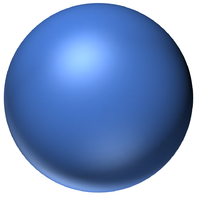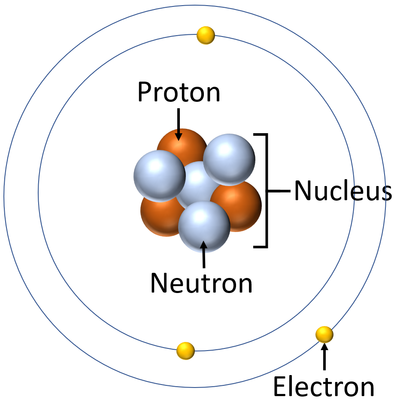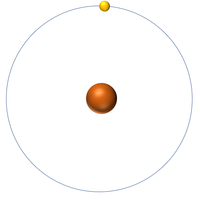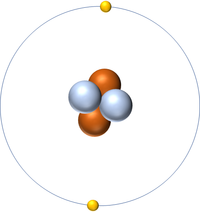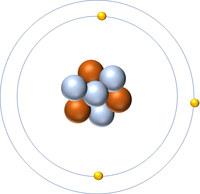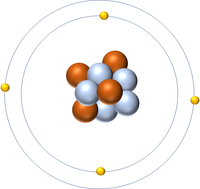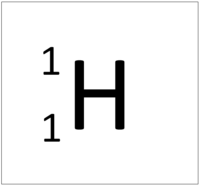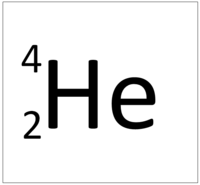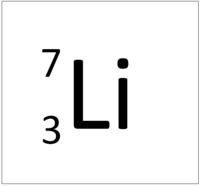Difference between revisions of "Atom"
(→About Atoms beyond The Dalton Model) |
|||
| Line 24: | Line 24: | ||
: Different [[atom]]s can have different numbers of [[proton]]s and [[neutron]]s. | : Different [[atom]]s can have different numbers of [[proton]]s and [[neutron]]s. | ||
: The simplest [[atom]] is [[Hydrogen]] which has 1 [[proton]] and 1 [[electron]] and no [[neutron]]s. | : The simplest [[atom]] is [[Hydrogen]] which has 1 [[proton]] and 1 [[electron]] and no [[neutron]]s. | ||
| + | |||
| + | ==Key Stage 4== | ||
| + | ===Meaning=== | ||
| + | An [[atom]] is a very small [[particle]] made of [[proton]]s, [[neutron]]s and [[electron]]s that can join with other [[atom]]s to make [[molecule|molecules]]. | ||
| + | |||
| + | ===About Atoms=== | ||
| + | : [[Atom]]s consist of a small, central [[Atomic Nucleus|nucleus]] containing [[proton]]s and [[neutron]]s surrounded by [[electron]]s [[Electron Orbital|orbiting]] the [[Atomic Nucleus|nucleus]]. | ||
| + | : The [[electron]]s [[orbit]] the [[Atomic Nucleus|nucleus]] in so called '[[Electron Orbital|electron shells]]. | ||
| + | {| class="wikitable" | ||
| + | |- | ||
| + | |[[File:AtomDiagram.png|center|400px]] | ||
| + | |- | ||
| + | | style="height:20px; width:200px; text-align:center;" |A [[diagram]] of an [[atom]]. | ||
| + | |} | ||
| + | : In an [[atom]] there is always the same number of [[proton]]s as [[electron]]s. If any [[electron]] is added or removed the [[atom]] becomes an [[ion]]. | ||
| + | |||
| + | : [[Atom]]s can be different [[element]]s depending on the number of [[proton]]s. | ||
| + | {| class="wikitable" | ||
| + | | style="height:20px; width:200px; text-align:center;" |'''Hydrogen''' | ||
| + | | style="height:20px; width:200px; text-align:center;" |'''Helium''' | ||
| + | | style="height:20px; width:200px; text-align:center;" |'''Lithium''' | ||
| + | | style="height:20px; width:200px; text-align:center;" |'''Beryllium''' | ||
| + | |- | ||
| + | |[[File:Hydrogen.png|center|200px]] | ||
| + | |[[File:Helium.png|center|200px]] | ||
| + | |[[File:Lithium.png|center|200px]] | ||
| + | |[[File:Beryllium.png|center|200px]] | ||
| + | |- | ||
| + | |[[File:HydrogenSymbol.png|center|200px]] | ||
| + | |[[File:HeliumSymbol.png|center|200px]] | ||
| + | |[[File:LithiumSymbol.png|center|200px]] | ||
| + | |[[File:BerylliumSymbol.png|center|200px]] | ||
| + | |- | ||
| + | | style="height:20px; width:200px; text-align:center;" |[[Hydrogen]] always has 1 [[proton]]. | ||
| + | | style="height:20px; width:200px; text-align:center;" |[[Helium]] always has 2 [[proton]]. | ||
| + | | style="height:20px; width:200px; text-align:center;" |[[Lithium]] always has 3 [[proton]]. | ||
| + | | style="height:20px; width:200px; text-align:center;" |[[Beryllium]] always has 4 [[proton]]. | ||
| + | |} | ||
| + | |||
| + | : [[Atom]]s of the same [[element]] can have different numbers of [[neutron]]s so they can be different [[isotope]]s of the same [[element]]. | ||
| + | |||
| + | ===History of Atoms=== | ||
| + | : The existence and structure of [[atom]]s was not always known. | ||
Revision as of 12:16, 23 November 2018
Contents
Key Stage 3
Meaning
An atom is a very small particle made of protons, neutrons and electrons that can join with other atoms to make molecules.
About Atoms in The Dalton Model
- In The Dalton Model atoms are shown as ball shaped particles. This makes it easier to draw diagrams of molecules.
| A picture of The Dalton Model of an atom. |
About Atoms beyond The Dalton Model
- Atoms are made of three smaller particles; the proton, neutron and electron.
- Protons and neutrons are found in the nucleus at the centre of an atom. Electrons are found orbiting the nucleus in 'shells'.
| A diagram of an atom. |
- In an atom the number of electrons is always the same as the number of protons in the nucleus.
- Different atoms can have different numbers of protons and neutrons.
- The simplest atom is Hydrogen which has 1 proton and 1 electron and no neutrons.
Key Stage 4
Meaning
An atom is a very small particle made of protons, neutrons and electrons that can join with other atoms to make molecules.
About Atoms
- Atoms consist of a small, central nucleus containing protons and neutrons surrounded by electrons orbiting the nucleus.
- The electrons orbit the nucleus in so called 'electron shells.
| A diagram of an atom. |
- In an atom there is always the same number of protons as electrons. If any electron is added or removed the atom becomes an ion.
| Hydrogen | Helium | Lithium | Beryllium |
| Hydrogen always has 1 proton. | Helium always has 2 proton. | Lithium always has 3 proton. | Beryllium always has 4 proton. |
- Atoms of the same element can have different numbers of neutrons so they can be different isotopes of the same element.
History of Atoms
- The existence and structure of atoms was not always known.
